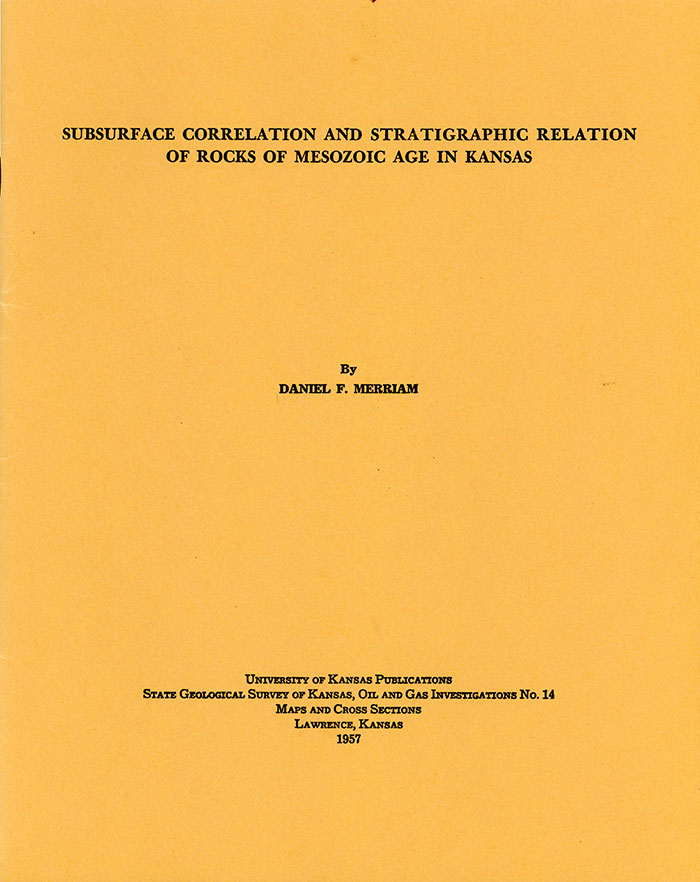Subsurface Correlation and Stratigraphic Relation of Rocks of Mesozoic Age in Kansas
DOI:
https://doi.org/10.17161/kgsbulletin.no..23584Abstract
Rocks of Mesozoic age in Kansas are recognized as belonging to the Triassic, Jurassic, and Cretaceous Systems. Mesozoic rocks unconformably overlie Permian strata and are in turn unconformably overlain by Tertiary and Pleistocene deposits; and they are mostly marine deposits, consisting of shale, sandstone, limestone, and chalk, but considerable amounts of nonmarine sandstone and clay are present. There is no commercial production of petroleum from beds of Mesozoic age in Kansas although other minerals, both fuel and nonfuel, have been and are being economically exploited at present.
To show the correlations and stratigraphic relations of Mesozoic rocks in the subsurface in Kansas, three cross sections are presented: one section, east-west, from Washington County to Cheyenne County; another, southeast-northwest, from Kiowa County to Cheyenne County; and the third, north-south, from Cheyenne County to Morton County. Correlation of beds is based mainly on a study of electric logs supplemented by sample study.
Rocks in Kansas between Permian Taloga formation and Jurassic Morrison formation are recognized as belonging to the Triassic Dockum (?) group. These beds, nonmarine in origin, have been identified only in the extreme southwestern part of the state and consist mostly of siltstone and sandstone. Maximum thickness of the group is about 320 feet. Rocks of Jurassic age have been assigned to the Morrison formation, which is present in about the western fifth of the state and only in the subsurface. These beds, probably fluvial in origin, consist of shale, sandstone, limestone, and some chert and anhydrite. The top of the chert beds in the Morrison forms an excellent marker horizon that can be traced over a large part of the Midcontinent region. Maximum thickness of the formation in the state is about 350 feet. The Cretaceous System, in the western two-thirds of the state, is divided into the Comanchean (lower) and Gulfian (upper) Series. Comanchean rocks are subdivided into the Cheyenne sandstone and Kiowa shale. The Cheyenne, predominantly sandstone, is probably nonmarine and unconformably overlies older strata. It attains a thickness of at least 260 feet. The overlying Kiowa shale, which is marine, has a maximum thickness of about 380 feet. The Gulfian Series is divided into six formations, lowest of which is the Omadi formation (Dakota formation in official State Geological Survey of Kansas nomenclature). Omadi is a new formational name for Kansas and is used here in the subsurface in place of the term Dakota. The formation contains three recognizable members (names also new to Kansas nomenclature), Cruise sandstone, Huntsman shale, and Gurley sandstone. Sandstone, shale, and clay are the predominating lithologic types. Omadi is in part marine and in part nonmarine and has a thickness of as much as 400 feet. Overlying the Omadi formation is Graneros shale, which is marine and attains a maximum thickness of about 100 feet. Greenhorn limestone, also marine, overlies Graneros shale and has a maximum thickness of about 100 feet. Carlile shale, about 300 feet of mostly marine strata, has three members, Fairport chalky shale, Blue Hill shale; and Codell sandstone. Next formation above the Carlile is the Niobrara, which is divided into Fort Hays limestone and Smoky Hill chalk. The Niobrara consists of chalk, limestone, and chalky shale and attains a maximum thickness of about 700 feet. Uppermost formation of the Cretaceous in Kansas is the Pierre shale. It may reach thicknesses of as much as 1,600 feet and, like the Niobrara, is marine. Cretaceous strata are unconformably overlain by nonmarine late Tertiary and Pleistocene deposits.
Sedimentary history as interpreted from Mesozoic rocks is closely related to the structural evolution of western Kansas and surrounding regions. Present structure of Mesozoic beds is the result of both Mesozoic and Cenozoic structural movements.

Downloads
Published
Issue
Section
License
Copyright (c) 2025 Daniel F. Merriam

This work is licensed under a Creative Commons Attribution-NonCommercial 4.0 International License.
